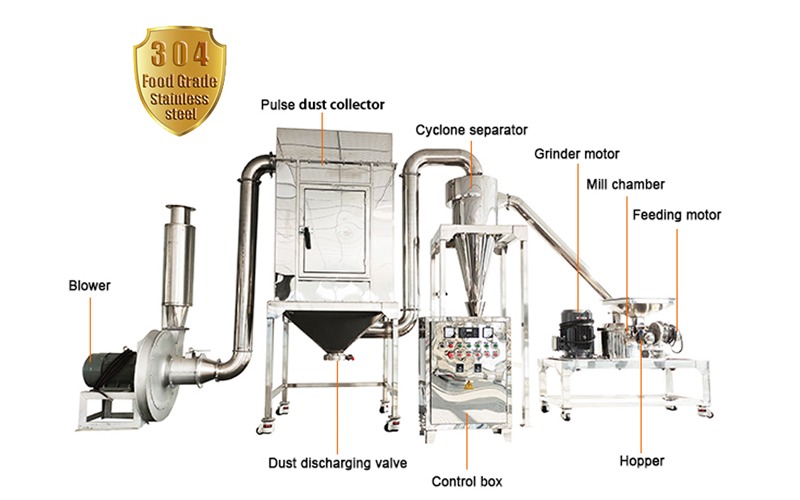In today’s fast-paced manufacturing world, precision and efficiency are key to staying competitive. The Ultra-fine grinder, a cutting-edge machine designed to reduce materials into ultra-fine particles, is revolutionizing industries across the globe. Whether you’re in pharmaceuticals, food processing, or chemicals, this powerful tool delivers unmatched versatility and performance. This article explores how the Ultra-fine grinder works, its applications, benefits, and why it’s the perfect addition to your production line—all optimized to help you make informed decisions and boost your business.
What is an Ultra-Fine Grinder?
An Ultra-fine grinder is a specialized machine engineered to grind materials into particles as small as a few microns. Unlike standard grinders, it uses advanced technology—such as high-speed blades or air jets—to achieve micronization, a process that creates powders with exceptional fineness and consistency. This precision makes it ideal for industries where particle size directly impacts product quality, such as pharmaceuticals, cosmetics, and food production.
With customizable settings and robust designs, Ultra-fine grinders cater to a wide range of materials, from soft spices to hard minerals, ensuring businesses can meet strict specifications with ease.
How Does an Ultra-Fine Grinder Work?
The magic of the Ultra-fine grinder lies in its innovative grinding mechanisms:
-
Mechanical Grinding: High-speed rotating blades or hammers generate intense impact and shear forces, breaking materials into tiny particles. The process repeats until the desired fineness is achieved.
-
Air Jet Grinding: High-velocity air jets collide particles against each other, a method called attrition, resulting in even finer powders—perfect for sub-micron applications.
Equipped with features like adjustable speeds and classifiers, the Ultra-fine grinder allows precise control over particle size distribution. This ensures consistent results, whether you’re grinding dry powders or wet slurries, making it a versatile solution for diverse production needs.
Key Applications of Ultra-Fine Grinders
The Ultra-fine grinder shines across multiple industries, delivering tailored solutions for specific challenges:
-
Pharmaceuticals: Finely ground active ingredients improve drug solubility and absorption, critical for effective medications like inhalables or fast-dissolving tablets.
-
Food Processing: Create ultra-smooth spices, flours, or additives that enhance flavor, texture, and shelf life—think instant coffee or creamy chocolate.
-
Chemicals: Produce pigments, catalysts, and advanced materials with optimized properties for brighter colors or faster reactions.
-
Cosmetics: Achieve silky-smooth powders for makeup and skincare, ensuring flawless application and a premium feel.
-
Mining: Increase mineral extraction efficiency by grinding ores into ultra-fine particles, boosting surface area for downstream processes.
These applications highlight the grinder’s ability to elevate product quality and streamline operations, no matter the sector.
Benefits of Investing in an Ultra-Fine Grinder
Why choose an Ultra-fine grinder for your business? Here are the standout advantages:
-
Enhanced Product Quality: Uniform, ultra-fine particles improve performance, from better drug efficacy to smoother food textures.
-
Higher Efficiency: Fast grinding with low energy use cuts production time and costs, maximizing your output.
-
Versatility: Process a wide range of materials—soft, hard, wet, or dry—with one machine, adapting to your unique needs.
-
Eco-Friendly: Minimize waste and energy consumption, aligning with sustainable manufacturing trends.
-
Scalability: From small batches to industrial-scale production, the grinder grows with your business.
These benefits translate into a strong return on investment, making the Ultra-fine grinder a smart choice for forward-thinking companies.
What to Look for in an Ultra-Fine Grinder
Choosing the right grinder means focusing on features that match your goals:
-
Precision Control: Adjustable settings for exact particle sizes tailored to your application.
-
Easy Maintenance: Simple designs with accessible parts reduce downtime and keep production running smoothly.
-
Durability: High-quality materials like stainless steel ensure long-term reliability, even under heavy use.
-
Safety: Built-in features like dust containment and emergency stops protect your team and workplace.
-
Customization: Options for specialized grinding elements or integration with existing systems.
Selecting a grinder with these qualities guarantees performance and value for years to come.
Why Partner with Us?
At [Your Company Name], our Ultra-fine grinders are designed with your success in mind:
-
Top-Tier Technology: Achieve consistent, ultra-fine results with our precision-engineered machines.
-
Built to Last: Rugged construction ensures durability in any production environment.
-
Cost-Effective: Energy-efficient designs lower your operational expenses.
-
Expert Support: From setup to maintenance, our team is here to guide you every step of the way.
Ready to transform your production process? Contact us to explore how our Ultra-fine grinders can meet your needs and drive your business forward.
Conclusion: Elevate Your Business with Ultra-Fine Grinding
The Ultra-fine grinder is more than a machine—it’s a gateway to innovation, quality, and efficiency. By delivering ultra-fine particles with precision, it empowers industries worldwide to create better products and optimize processes. Whether you’re grinding pharmaceuticals for life-saving drugs or spices for gourmet dishes, this machine is your key to staying ahead.
Take the next step today. Reach out to [Your Company Name] for a demo, quote, or expert advice on how our Ultra-fine grinders can revolutionize your operations. Let’s unlock the power of precision together!











